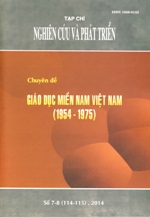Chương trình giáo dục và sách giáo khoa thời Việt Nam Cộng hòa/Education programs and textbooks in the Republic of Vietnam
Tóm tắt
Bài viết trình bày diễn tiến của chương trình giáo dục (tiểu học và trung học) và hệ thống sách giáo khoa (từ tiểu học đến đại học) ở miền Nam thời Việt Nam Cộng hòa. Qua đó, có thể nhận thấy chương trình học và sách giáo khoa thời kỳ này có cả những mặt ưu điểm lẫn khuyết điểm.
Về chương trình học, mặt khuyết điểm tồn tại khá nhiều, bị nhiều người phê phán, cho là còn chịu ảnh hưởng của chương trình học cũ (thời phong kiến và thời Pháp thuộc) nên còn quá nặng mà lại thiên về thi cử, thoát ly khỏi thực tế cuộc sống. Tuy nhiên, các nhà chức trách giáo dục thời ấy đã biết lắng nghe và tiếp thu các ý kiến phê phán, nên qua nhiều lần sửa đổi, chương trình học ngày càng nhẹ đi, nội dung giảng dạy cũng sát với thực tế hơn, biểu hiện qua các chương trình giáo dục Tiểu học Cộng đồng và Trung học Tổng hợp.
Về sách giáo khoa, ngoài Bộ Giáo dục, tư nhân có quyền tự do biên soạn và xuất bản sách giáo khoa dựa theo chương trình quy định của nhà nước. Nhờ tính cạnh tranh trong quyền tự do biên soạn và xuất bản của tư nhân và quyền chọn lựa của người sử dụng nên sách giáo khoa thời kỳ này rất phong phú, chất lượng ngày càng được cải tiến tốt hơn để đáp ứng nhu cầu của người học.
ABSTRACT
The paper presents the progress of education program (primary and secondary) and textbook system (from primary to higher education) in the Republic of Vietnam. From the information in the article, it can be said that the curriculum and textbooks during that period had both advantages and disadvantages.
About the national curriculum, there were still shortcomings; simultaneously, it was criticized for being influenced by outdated curriculums (under the colonial and feudal regime), which were so heavy and attached importance to examinations, escaping from the reality of life. However, the education authorities at that time listened to critical opinions and absorbed new ideas and, as a result, after some amendments, the curriculum was not so heavy and syllabus contents were closer to reality, which were represented by educational programs of Community Primary and Comprehensive High School.
Apart from the Ministry of Education, private sectors had the right to compile and publish textbooks in conformity with the education program regulations of the government. Thanks to the competition in textbook compilation and publishing of private sectors and the option of the users, there were a lot of diverse textbooks with well-improved quality to meet the needs of learners.

